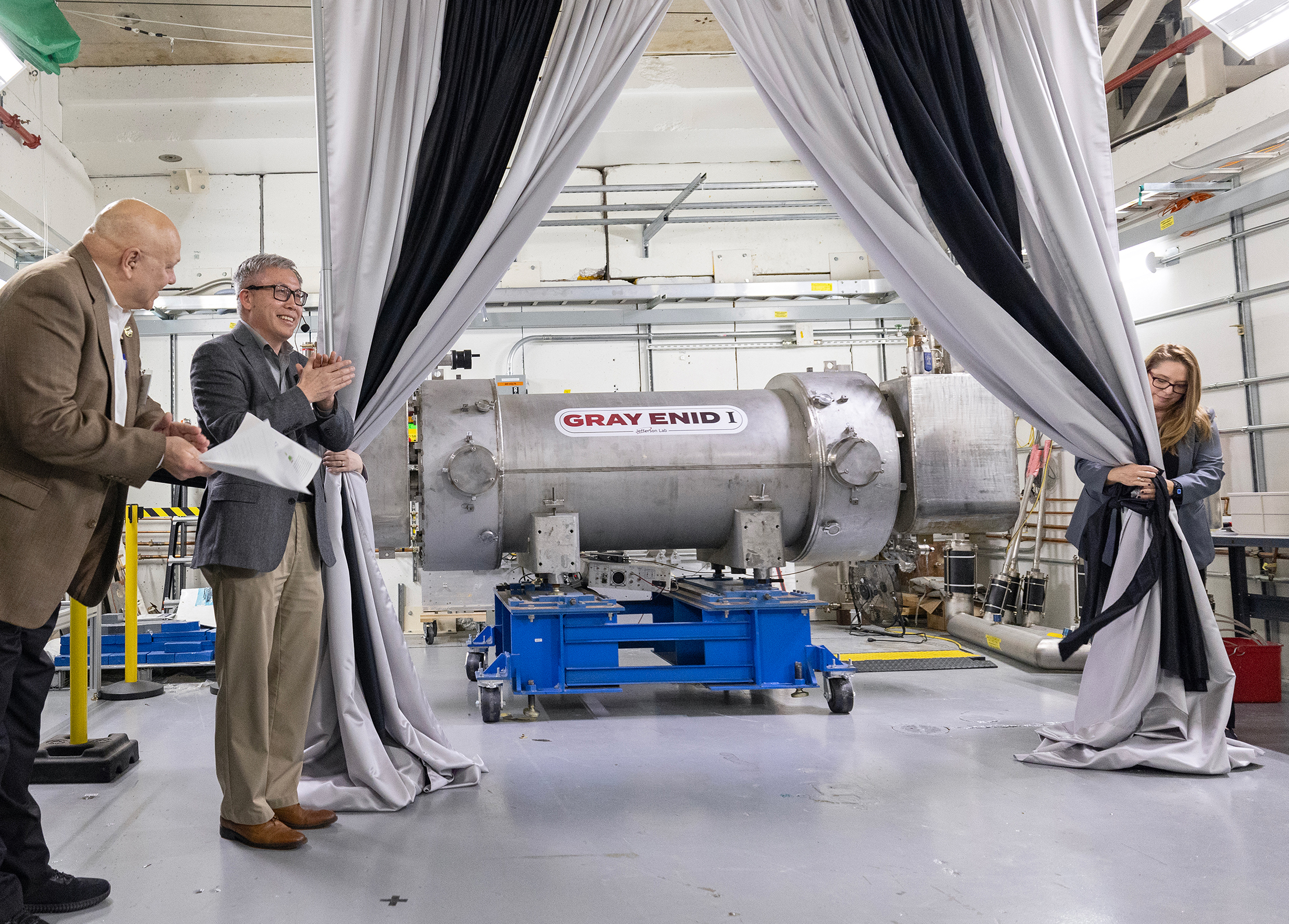Jefferson Lab Dedicates Niobium-Tin Particle Accelerator Prototype
 More than 30 of the world’s most advanced particle accelerators rely on one technology: superconducting radio-frequency (SRF). This technology, typically powered by pure niobium metal, has seen recent advancements with the introduction of niobium-tin alloys, which promise greater efficiency. The US Department of Energy’s (DOE) Thomas Jefferson National Accelerator Facility (Jefferson Lab) is at the forefront of this new era, testing an accelerator based on niobium-tin alloy technology. The team has successfully tested the first niobium-tin alloy cryomodule, a prototype section of a particle accelerator, which can accelerate electrons to energies exceeding 10 million electron-volts. This cryomodule, named Gray Enid I, is now being prepared for its first electron beam tests.
More than 30 of the world’s most advanced particle accelerators rely on one technology: superconducting radio-frequency (SRF). This technology, typically powered by pure niobium metal, has seen recent advancements with the introduction of niobium-tin alloys, which promise greater efficiency. The US Department of Energy’s (DOE) Thomas Jefferson National Accelerator Facility (Jefferson Lab) is at the forefront of this new era, testing an accelerator based on niobium-tin alloy technology. The team has successfully tested the first niobium-tin alloy cryomodule, a prototype section of a particle accelerator, which can accelerate electrons to energies exceeding 10 million electron-volts. This cryomodule, named Gray Enid I, is now being prepared for its first electron beam tests.
Grigory Eremeev, a former Jefferson Lab staff scientist and now a senior scientist at DOE’s Fermi National Accelerator Laboratory, sees Gray Enid I as a major milestone. “This cryomodule was built with my early career award and partnerships among researchers and national labs,” Eremeev said. “I hope it works well in the upgraded injector test facility and that it does what we hope it will do. This would be a significant milestone.” At a recent event to dedicate the new cryomodule, Michelle Shinn, DOE’s program manager for Industrial Concepts in the Office of Nuclear Physics, emphasized the difficulty of the achievement. “To actually not just coat a cavity, but coat two cavities, put them into a cryomodule, fully check them, and accelerate electrons—that's gutsy,” said Shinn.
Superconducting Radiofrequency Particle Accelerators
Niobium, a metal known for its superconducting properties, has been used in a variety of applications, from strengthening materials to improving the efficiency of solar cells. However, its most critical application is in superconducting technology. Niobium loses its resistance to electricity at low temperatures, making it essential for high-powered magnets and quantum computers.
In particle accelerators, specially formed niobium cavities are cooled to just a few degrees above absolute zero—around 2 Kelvin. These cavities, shaped like a stack of donuts with a hollow center, accelerate particles by imparting energy from radio frequency waves. When superconducting, the cavities can store energy with minimal losses, accelerating a continuous beam of particles. The Continuous Electron Beam Accelerator Facility (CEBAF) at Jefferson Lab was the first large-scale linear accelerator to use SRF technology. Due to its efficiency in delivering high-precision beams, CEBAF has been instrumental in groundbreaking experiments in nuclear physics. Today, CEBAF continues to be a key research facility, supporting over 1,650 nuclear physicists worldwide.
Jefferson Lab has since led the way in SRF research, contributing to advancements in particle accelerators used at various DOE labs, including the Spallation Neutron Source at Oak Ridge National Laboratory and the Linac Coherent Light Source at SLAC National Accelerator Laboratory. Despite these successes, researchers have recognized that the current generation of accelerators, which rely solely on niobium, is reaching its efficiency limits. This realization has spurred the exploration of niobium alloys, such as niobium-tin, as a way to continue pushing the boundaries of SRF technology.
Advancing Particle Accelerators with Niobium-Tin Alloys
Niobium-tin (Nb₃Sn) alloys, which become superconducting at 18.3 K, offer a significant improvement over pure niobium, whose transition temperature is lower. Researchers have started using a vapor diffusion process to create a thin niobium-tin layer on niobium cavities. This process involves vaporizing tin inside a niobium cavity at temperatures exceeding 1,100 °C, resulting in the formation of the superconducting layer.
The initial tests of this new cryomodule did not go as planned. Eremeev explained that earlier prototype cavities did not perform well in tests. “We started with some original CEBAF cavities that we still had available, but we realized that we couldn’t get a good coating on the older surfaces,” he said. Additionally, the assembly process posed challenges. Tuning the cavities to the correct frequency typically requires deforming them, but this warped the carefully crafted niobium-tin coating. “We went and bought some new cavities from the vendor. These new cavities had a good niobium substrate to work with,” Eremeev said.
The new cavities performed much better. Uttar Pudasaini, a Jefferson Lab SRF scientist, noted that while older coated cavities struggled to dissipate heat, the new cavities demonstrated improved superconductivity at higher temperatures. “They are able to remain superconducting at higher temperatures,” Pudasaini said.
The success of the new cavities led to the creation of a one-quarter cryomodule, a section of SRF accelerator that includes components to support and insulate the cavities. This cryomodule was tested in Jefferson Lab’s Cryomodule Test Facility, where it was cooled to 4.4 K and 2 K for testing with SRF fields. The tests confirmed that the cryomodule could accelerate electrons to over 10 MeV at both temperatures.
Eremeev emphasized the significance of these results. “It basically got similar results to what we saw in the vertical tests,” he said. This successful demonstration could signal the possibility of operating SRF accelerators at higher temperatures—around 4 K—rather than the current 2 K. This would reduce the complexity of cryogenic systems and lower operational costs.
If the results hold in electron beam tests, it could pave the way for more efficient and cost-effective SRF accelerators. These accelerators have the potential for a wide range of applications, including cancer treatment, sterilization of medical devices and the remediation of wastewater.
Moving Forward with Gray Enid I
The team is now preparing to install Gray Enid I into a small accelerator at Jefferson Lab’s Upgrade Injector Test Facility (UITF), which will test its performance in a real accelerator environment. “Gray Enid I is named after earlier technology installed here in CEBAF in 1990,” said Rongli Geng, who heads the SRF Science and Technology department at Jefferson Lab.
Gray Enid I represents four decades of investment in SRF technology, spearheaded by the DOE’s Office of Science and Office of Nuclear Physics. “If there is a will, there’s a way. After all the hard work and overcoming obstacles, it’s good to see this project finally coming to fruition,” Eremeev concluded. www.jlab.org
Unveiling the Unveiling Nb3SN. Credit: Jefferson Labs


